Atlantic Monthly Contributors's Blog, page 155
May 28, 2016
Pop's Dueling Definitions of Dangerous Women

In titling her memoir Not That Kind of Girl, Lena Dunham subverted a phrase that some people might otherwise use to diss her brand of oversharing, sex-positive womanhood. But on their new album 7/27, Fifth Harmony’s song “Not That Kind of Girl” seems to put its title back in the hands of traditionalists. Over a confetti-like explosion of ‘80s tropes—Prince synths, Michael Jackson enunciations, Whitney Houston runs—the girl-group’s members warn guys at the bar not to incorrectly classify them based on their hotness. Missy Elliott shows up to clarify exactly what the misunderstanding might be: “I'm not the kinda girl you can freak on the first date / I'm straight, that's right, I'll make ya wait,” and “What you think, I'm a thot?”
It’s a somewhat surprising sentiment in an era where slut-shaming is so often, well, shamed. Especially since, after forming on The X Factor in 2012, Fifth Harmony have skied in the wake of Beyoncé and other titans of aughts pop feminism, using the notion of #flawlessness and being not bossy but a boss for slick, heavily rhythmic dance anthems intertwining romance and empowerment. But “Not That Kind of Girl" is a rare finger-wagging formulation of a viewpoint otherwise contained in affirmations. The group sings about sex plenty, but their current hit “Work From Home” is typical in portraying freaky bedroom fun as glorious mostly in the bounds of a relationship. Another track, “Gonna Get Better,” is about sticking with a guy even when he can’t pay for nice things. Club culture, they suggest, doesn’t have to be hook-up culture, surely to the relief of a some of their teen and tween fans’ parents.
The tendency to portray one gender’s goodness and badness as tied to promiscuity and material desperation has, as the music critic Ann Powers explained during the summer of “Blurred Lines,” been with pop probably for as long as pop has existed. The last mass realization of how creepy the motif’s implications could be came from Drake’s “Hotline Bling,” a song that sounds innocuous until you notice all the condemnation Drake hurls at a woman who seems like she’s having a liberated, enviable fun with travel and bubbly beverages.
Though the good girl/bad girl trope’s rooted in gender norms, it can also serve aesthetic functions and be scrambled based on situation and singer. Take Ariana Grande’s new album Dangerous Woman, which puts its concept in the title and in its cover. The ponytailed ex-Nickelodeon star is in her bad-girl phase, except she’d prefer “woman” to “girl.” Pitchfork’s Quinn Moreland counted 19 instances of the word “danger” in the lyrics; “scandalous,” “reckless,” and “bad decisions” also show up. Grande seems to be using these keywords more earnestly than she did in her great recent SNL hosting turn where she complained about lacking for a true controversy to rocket her to grown-up stardom. (The donut-licking debacle of 2015, apparently, didn’t quite get her there.) But she and her songwriters are also playing with the meaning of dangerous womanhood, trying to turn a story of loving commitment into something edgy—in part to serve Grande’s image and in part to serve up more interesting music.
The rumor that Grande’s dating her backup dancer Ricky Alvarez remains artfully half-confirmed, with the singer refusing to provide specifics in interviews yet members of her camp anonymously dishing to the press about which songs off her album refer to him. It’s a strategy that supports Dangerous Woman’s theme of inexplicably forbidden romance. “It used to be easy / For someone to steal me /
Now all my emotions /Are all cause of you, boy,” she sings on “Sometimes,” whose acoustic guitars and “la la la”s suit her smittenness. But elsewhere, she’s freaked out: “Don’t let them see us,” she cries on the gloriously rippling house single “Into You.” This anxiety about what seems like a cute age-appropriate relationship perhaps owes to Grande’s status as one of the most scrutinized young women on Earth—the same concept behind Taylor Swift’s cheekily gothic “I Know Places.” Or perhaps the danger meme more has to do with the universal realization that falling for someone is a risky proposition.
Most importantly for listeners on the hunt for memorable summertime pop, Grande’s team (the album’s executive-produced by Grande, Max Martin, and Savan Kotecha) have back up the lyrical concept by injecting darker flavors into bubblegum. Dangerous Woman reaches for Shirley Bassey vibes as much as it reaches for the expected Calvin Harris ones, and tying the track list’s self-conscious stylistic diversity together is a deep, distorted synthesizer tone that recalls heavy metal guitars or flickering Tesla coils. That sound lies under the chorus of “Into You,” creating crucial tension. It envelops the workout-playlist excellence of “Everyday,” where Future repeating the track’s title feels like a beacon flickering in a dust cloud. The production adds moments of queasy fright to the mall pop of “Sometimes,” the reggae sugar rush of “Side to Side,” and the overdetermined rock-and-roll epic that is the title track. Along with Grande’s vocal agility and Martin’s talent for unlocking the gate between the ears and the longterm memory, the distinct rumbling motif makes Dangerous Woman one of the better pop releases this year.
Fifth Harmony’s 7/27 also has a sonic trademark that fits with the narrative it spins about elevating oneself through fierceness. Rather than going low and growly a la Grande, their producers have affixed neon and pastel highlights to their solidly written R&B and hip-hop-inflected jams about what being independent but in love feels like. Sometimes this is done pretty cleverly, as on the sequined excitement of “Not That Kind of Girl.” “All in My Head” brings in the most exuberant rapper of our times, Fetty Wap, to very catchy effect. For “I Lied,” the chorus goes, “Love never got me this high,” and as the girls sing that last words a barrage of electronic screeches not unlike dolphin sounds shoot up in, yes, the high end.
But one problem: Those sounds, and many of the other ones on the album, are becoming very familiar to the average radio listener. Many tracks feature Blood and Kygo, producers-of-the-moment whose use of tropical music signifiers (and a riff that’s earned a pretty compelling plagiarism lawsuit) helped give Justin Bieber’s Purpose its appealingly serene vibe last year. The success of that album and its influences makes 7/27, and all the other recent pop works mining the same sonic vein, feel second-generation: bliss out of a box. I won’t label any of these women, Grande or the members of Fifth Harmony, good or bad, but I do know which one has done a better job of making the old feeling of falling in love sound new again.

A Possible Republican Truce on Obamacare
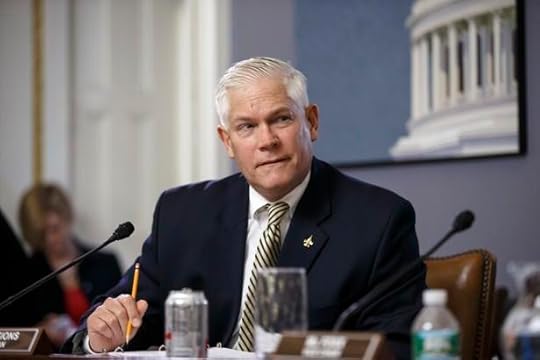
Last week, a pair of Republican lawmakers unveiled the world’s greatest health-care plan.
That’s not an endorsement, or even an opinion. It’s the title of the bill: H.R. 5284—The World’s Greatest Healthcare Plan Act of 2016.
Yet the proposal’s Trumpian moniker is not the most significant thing about it. This is an expansive bill, sponsored by a member of the House Republican leadership and a member of the health committee in the Senate, that seeks to enact conservative, market-oriented reforms to the insurance industry but does not—repeat, does not—repeal the Affordable Care Act. Instead, Representative Pete Sessions of Texas and Senator Bill Cassidy of Louisiana are proposing to allow people to leave the Obamacare exchanges and instead receive a $2,500 tax credit (plus $1,500 for each child) to purchase health insurance on the private market or put in a health-savings account.
Obamacare, in other words, would be optional.
“If you want to stay there, you can,” Sessions told me, referring to the millions of Americans who now have insurance through the state or federal exchanges established under the ACA. Or, to borrow a now-discredited line from Democrats: If you like your Obamacare, you can keep it.
What happened to “repeal and replace?” What happened to ripping Obamacare out of the law “root and branch”? Is this surrender?
“I cut a compromise,” Sessions said. “It is a compromise bill that I believe is fair.”
“I cut a compromise. It is a compromise bill that I believe is fair.”
The 61-year-old Texan, now serving his seventh term in the House, is no back-bencher. As chairman of the Rules Committee, he’s a member of the leadership team under Speaker Paul Ryan. And neither he nor Cassidy, who won a Senate seat in 2014 after three terms in the House, are mushy moderates tacking to the center to save their jobs. Sessions ran the House GOP’s campaign arm in 2010, the year Republicans won back the majority on a message of repealing and replacing the just-enacted health care law. When Majority Leader Eric Cantor lost his primary in an upset two years ago, Sessions briefly waged a failed bid to succeed him by positioning himself as the more conservative candidate. (Kevin McCarthy, the heavy favorite, won easily.) In his race for the Senate that same year, Cassidy harped on Senator Mary Landrieu’s support for the health-care law.
So no, Sessions and Cassidy have not had a change of heart on Obamacare. And to a large extent, their bill is merely the latest example of the GOP’s try-anything approach to countering the law, which I wrote about last week. But at least for Sessions, the proposal is a recognition that for both political and policy reasons, scrapping the law and starting from scratch is a virtual impossibility. As Republicans have learned many times over, they need not only Congress but the White House to repeal Obamacare (and they probably need more than a slim majority in the Senate at that). Even if they had the votes to do so, fully repealing the law would still be a Herculean task because, as Sessions explained, Democrats “literally wiped out all law” relating to health care when then enacted the ACA in 2010. “I view that those two options are both very difficult to do,” Sessions said.
The Sessions/Cassidy bill does not leave Obamacare untouched by any means. It eliminates both the individual and employer mandates, although businesses that choose to remain in the current system would be subject to the existing penalties and requirements under the law. Individuals who choose to opt out would not have to buy insurance, but they would not be eligible for the tax credit if they choose to remain uninsured. Many previous Republican proposals have taken a hatchet to Obamacare without repealing it entirely, and the party has succeeded in working with Democrats to make modest changes in the last couple of years. But this latest bill is notable for its vision of adding an entirely new system on top of the Affordable Care Act’s underlying infrastructure. It’s not merely tinkering with Obamacare, but nor is it entirely scrapping it.
Using health-care tax credits as a centerpiece is a hallmark of Republican plans, and this one is similar to what John McCain proposed as a presidential candidate in 2008, said John Goodman, a veteran health-policy analyst who advised Sessions and Cassidy on their plan over the last 18 months. “This is the reform they should have adopted in the first place,” he said. As Goodman sees it, the Sessions/Cassidy bill will ultimately be a replacement for Obamacare because while the exchanges are “grandfathered in” people will ultimately choose to opt out as more insurance companies leave and premiums and deductibles increase. (The lawmakers’ decision to keep the exchanges at all, Goodman said, was for “political” reasons.)
“After more than six years, we are glad that at least two Republicans have given up on repealing the Affordable Care Act.”
Don’t count on much bipartisan support for the bill, despite the fact that it keeps the Obamacare exchanges intact. Democrats won’t go for anything that guts the individual and employer mandates, which, they note, originated as Republican ideas in the 1990s. But they are cheering the Sessions/Cassidy bill as a small vindication of their long-standing position that Republicans would eventually come around to, or at least get used to, Obamacare. “After more than six years, we are glad that at least two Republicans have given up on repealing the Affordable Care Act,” said Drew Hammill, the spokesman for House Minority Leader Nancy Pelosi.
The question for Sessions and Cassidy is whether splitting the difference will win them many votes at all. Under Ryan’s direction, House Republicans are intent on coalescing around a health-care plan—if not an actual bill—in the coming weeks, but the task force of committee chairmen leading the effort is expected to embrace a proposal that fully repeals and replaces Obamacare, consistent with the party message. And when the speaker was asked about the Sessions/Cassidy bill earlier this week, he offered something far short of a ringing endorsement. “I don’t even know what his bill does,” he said initially, before adding: “The point is, everybody should feel free to offer their ideas. That’s Congress.”
Sessions is pitching his bill as one that is aimed not so much at the 12.7 million people who are getting their insurance directly through the Obamacare exchanges but for the millions more who are not. “You’ve got to recognize that health care, for at least another 150 million Americans, is getting not only more expensive but is in doubt,” he said. “The Affordable Care Act did not cure the problems of the uninsured.” Republicans, Sessions said, need to have “a fair, well thought-out bill” to bring to voters this fall. The challenge is persuading a conservative base, and a conservative Republican conference in the House, on a truce with Obamacare that many still aren’t ready to stomach. Sessions and Cassidy are stepping out ahead, unsure if anyone will follow. “I’ve spoken to every member, and they find it intriguing and interesting,” Sessions told me, “and they by and large have said to me, ‘Great, go sell it.’ And that’s what I’ll do.”

May 27, 2016
More Prison Time for Argentina's Last Dictator
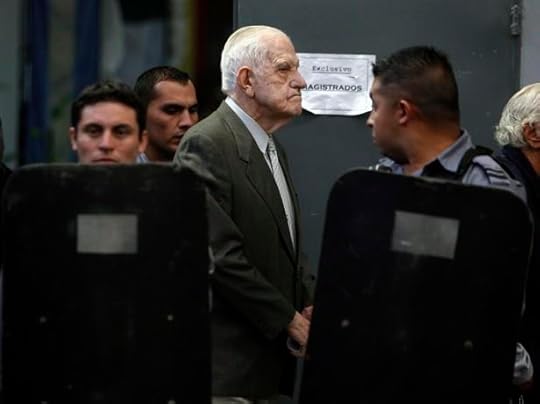
The last military dictator of Argentina was sentenced to 20 years in prison on Friday for his involvement in a covert campaign that hunted down his political opponents.
Reynaldo Bignone, who served as the country’s president from 1982 to 1983, was implicated for his involvement in Operation Condor, a covert program between six South American dictators and their secret police. As the Associated Press reports:
The trial, which began in 2013, involves 16 other former military officials and 105 victims from at least four countries. A key piece of evidence is a declassified FBI agent's cable, sent in 1976, that described in detail the conspiracy to share intelligence and eliminate leftists across South America.
Operation Condor was launched by Chilean dictator Augusto Pinochet who enlisted other South American dictators. It grew to include Chile, Argentina, Bolivia, Brazil, Paraguay and Uruguay.
But the covert conspiracy went further than that: the U.S. government later determined that Chilean agents involved in Condor killed the country's former ambassador Orlando Letelier and his U.S. aide Ronni Moffitt in Washington, D.C., in September 1976, and tracked other exiles across Europe in efforts to eliminate them.
Bignone, who is 88 years old, is already serving a life sentence for other human-rights violations he committed after the 1976 coup while he was a general, including his involvement in the torture and killing of 56 people.

The Coming Storms of the Southeast

Coastal areas of Georgia, South Carolina, and North Carolina should expect intense rains in the next 36 hours.
The U.S. National Hurricane Center issued a tropical storm warning on Friday afternoon, saying a tropical cyclone could dump two-to-four inches of rain starting Saturday afternoon. Sustained winds could hit 35 miles-per-hour. As the Associated Press reports, this is just the beginning of a strong storm season:
U.S. government forecasters expect a near-normal Atlantic hurricane season, after three relatively slow years. But they also say climate conditions that influence storm development are making it difficult to predict how many hurricanes and tropical storms will arise over the next six months.
The National Oceanic and Atmospheric Administration's season outlook calls for 10 to 16 named storms, with four to eight hurricanes and one to four "major" ones with winds reaching 111 mph and up.
The Atlantic hurricane season officially starts June 1.
This storm, centered on Charleston, South Carolina, is the season’s second tropical cyclone.

The Sanders-Trump Debate Was Never Going to Happen
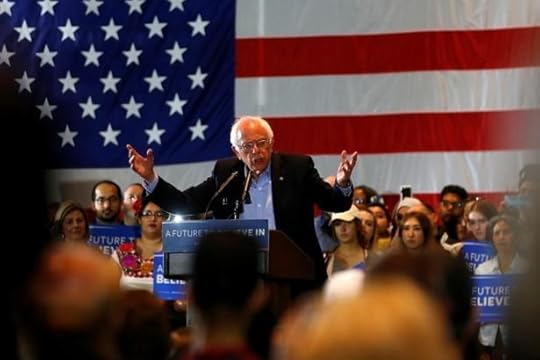
In a not-so-shocking turn of events, Donald Trump will not debate Bernie Sanders, depriving the American people of the least probable tête-à-tête since Billie Jean King and Bobby Riggs squared off in 1973.
In what’s becoming a pattern—from self-funding his campaign to the minimum wage—it turns out that Trump wasn’t serious about the promise he made, speaking to Jimmy Kimmel on Wednesday, to debate Bernie Sanders. Perhaps the Republican nominee thought it was a joke. Sanders, however, did not, and quickly accepted the “offer.” Trump quickly backpedaled, with aides saying he didn’t really intend to debate:
Multiple sources tell @Cbsnews that Trump was kidding about debating Sanders & it will never happen. (H/t @stevechaggaris and @MajorCBS)
— Sopan Deb (@SopanDeb) May 26, 2016
Then Trump, apparently unable to help himself, back-backpedaled (or repedaled?) saying while campaigning in North Dakota that “I’d love to debate Bernie, but they’d have to pay a lot of money for it.” He said the debate would have to be in a “big arena” and raise $10 and 15 million “for maybe women’s health issues or something.” Not the most solid of pledges, it seemed.
Still, it was enough for the Sanders campaign. Around 3:30 p.m. on Friday his campaign issued a statement, saying it had received two offers from broadcast networks to host the debate and make a large charitable gift.
We are prepared to accept one of those offers and look forward to working with the Trump campaign to develop a time, place and format that is mutually agreeable. Given that the California primary is on June 7, it is imperative that this all comes together as soon as possible. We look forward to a substantive debate that will contrast the very different visions that Sen. Sanders and Mr. Trump have for the future of our country.
But Trump was never going to accept, and that’s when he, like a jock who had suckered a nerd into believing they would hang out, pulled the rug out from under Sanders. A little after 4 p.m., Trump issued a rambling little statement, using the declaration that he had passed the magical 1,237-delegate mark on Thursday as an excuse for backing out. Trump’s statement both validated Sanders’s claim that the Democratic nomination was fixed against him and at the same time used it as a pretext for skipping out.
“Based on the fact that the Democratic nominating process is totally rigged and Crooked Hillary Clinton and Deborah Wasserman Schultz will not allow Bernie Sanders to win, and now that I am the presumptive Republican nominee, it seems inappropriate that I would debate the second place finisher,” he said.
Trump also claimed—contra Sanders—that the networks wouldn’t ante up for charity: “As much as I want to debate Bernie Sanders—and it would be an easy payday—I will wait to debate the first place finisher in the Democratic Party.” This isn’t the first time Trump has tried to tie his involvement in a debate to charity, unsuccessfully.
Trump comes out of his looking like an disingenuous schoolyard bully, but then that’s his stock in trade. Sanders comes out of it looking awfully thirsty, having gone after the bait in his increasingly futile quest for the Democratic nomination. Instead, he made himself a pawn in a Trump publicity game. Who knows what it means for Hillary Clinton. Some pro-Clinton pundits, like Jonathan Chait, were convinced that the debate would have been terrible news for Clinton, since Trump would likely have used the occasion to attack Clinton without response, while both would have undermined the legitimacy of her nomination. Who can say, though? Both Trump and Sanders are unpredictable, inconsistent debaters. It could have been a snooze, or it could have been a fracas. It would have been loud, and the Queens-Brooklyn accent showdown would have been tremendous.

What About Nagasaki?

In a somber acknowledgment of the impact of nuclear weapons, President Obama on Friday visited Hiroshima, where 120,000 Japanese, most of them civilians, were killed when the United States dropped an atomic bomb on the city on August 6, 1945.
Obama is the first sitting U.S. president to visit the city. While he did not expressly apologize for the bombing, he did honor the dead and looked toward a future without weapons of mass destruction.
“That is the future we can choose,” he said after laying a wreath at Peace Memorial Park. “A future in which Hiroshima and Nagasaki are known not as the dawn of atomic warfare but as the start of our own moral awakening.”
It was a touching tribute to Hiroshima, and a rare mention of the other city on which the U.S. dropped an atomic bomb. The two cities have been coupled for the impact of the events that ultimately led to Japan’s surrender in World War II. But Nagasaki’s story is often untold.
Three days after the U.S. dropped an atomic bomb on Hiroshima, it set its eyes on Nagasaki. On August 9, the U.S. dropped an atomic bomb on the city of 263,000. The blast created 624 mile-per-hour winds and 7,050 degrees of heat. The bomb was more powerful than the one dropped on Hiroshima, but the hills of the city blocked some of the damage. Still, 75,000 people ultimately died from the explosion. Only 150 of those deaths were soldiers.
William L. Laurence, The New York Times reporter who served as an eyewitness to the bombing, said Nagasaki was chosen that night because the aircrafts circled other potential targets but “found no opening in the thick umbrella of clouds that covered them. Destiny chose Nagasaki as the ultimate target.”
We flew southward down the channel and at 11:33 crossed the coastline and headed straight for Nagasaki about a hundred miles to the west. Here again we circled until we found an opening in the clouds. It was 12:01 and the goal of our mission had arrived.
We heard the pre-arranged signal on our radio, put on our ARC welder's glasses and watched tensely the maneuverings of the strike ship about half a mile in front of us.
"There she goes!" someone said. Out of the belly of the Artiste what looked like a black object came downward.
Captain Bock swung around to get out of range, but even though we were turning away in the opposite direction, and despite the fact that it was broad daylight in our cabin, all of us became aware of a giant flash that broke through the dark barrier of our ARC welder's lenses and flooded our cabin with an intense light.
We removed our glasses after the first flash but the light still lingered on, a bluish-green light that illuminated the entire sky all around. A tremendous blast wave struck our ship and made it tremble from nose to tail. This was followed by four more blasts in rapid succession, each resounding like the boom of cannon fire hitting our plane from all directions.
Observers in the tail of our ship saw a giant ball of fire rise as though from the bowels of the earth, belching forth enormous white smoke rings. Next they saw a giant pillar of purple fire, 10,000 feet high, shooting skyward with enormous speed.
By the time our ship had made another turn in the direction of the atomic explosion the pillar of purple fire had reached the level of our altitude. Only about 45 seconds had passed. Awe-struck, we watched it shoot upward like a meteor coming from the earth instead of from outer space, becoming ever more alive as it climbed skyward through the white clouds. It was no longer smoke, or dust, or even a cloud of fire. It was a living thing, a new species of being, born right before our incredulous eyes.
At one stage of its evolution, covering missions of years in terms of seconds, the entity assumed the form of a giant square totem pole, with its base about three miles long, tapering off to about a mile at the top. Its bottom was brown, its center was amber, its top white. But it was a living totem pole, carved with many grotesque masks grimacing at the earth.
Then, just when it appeared as though the thing has settled down into a state of permanence, there came shooting out of the top a giant mushroom that increased the height of the pillar to a total of 45,000 feet. The mushroom top was even more alive than the pillar, seething and boiling in a white fury of creamy foam, sizzling upwards and then descending earthward, a thousand old faithful geysers rolled into one.
It kept struggling in an elemental fury, like a creature in the act of breaking the bonds that held it down. In a few seconds it had freed itself from its gigantic stem and floated upward with tremendous speed, its momentum carrying into the stratosphere to a height of about 60,000 feet.
But no sooner did this happen when another mushroom, smaller in size than the first one, began emerging out of the pillar. It was as though the decapitated monster was growing a new head.
As the first mushroom floated off into the blue it changed its shape into a flower-like form, its giant petal curving downward, creamy white outside, rose-colored inside. It still retained that shape when we last gazed at it from a distance of about 200 miles.
Six days later, Japan surrendered.
The impact of the second atomic bomb is the subject of historical debate. In the aftermath of the war, the U.S. argued it was instrumental and necessary in encouraging Japan’s surrender. Others disagree, though.
Susan Southard, in a 2015 column for The New York Times, argues the narrative that the atomic bomb dropped on Nagasaki brought about the end of the war is a false one. She writes:
But it is now well known that the surrender was prompted at least as much by the Soviet Union’s decision to join the Allies in the war against Japan. Just 11 hours before the Nagasaki bombing, 1.5 million Soviet troops crossed into the Japanese puppet state in Manchuria, in northern China, and attacked the depleted Japanese Army there on three fronts.
The United States expected the Soviet action, but the delivery of the second atomic bomb was not dependent on the timing of the Soviet invasion, Tokyo’s response, or even a specific order from President Harry S. Truman. His sole directive had been to use nuclear weapons on Japan “as made ready” — and on Aug. 8, the second bomb’s assembly was complete.
The next morning — 30 minutes before the Nagasaki bombing — Japan’s Supreme War Council convened to try yet again to find agreement on surrender terms. Stalin’s declaration of war had ended any last hope of Soviet help in attaining more favorable surrender terms.
Council members pressing for immediate surrender were gravely concerned about lack of food and supplies for Japanese troops, the dire domestic situation and the Hiroshima bombing. Militarists were willing to fight to the death for the guaranteed preservation of Emperor Hirohito’s postwar sovereignty. When news of the Nagasaki attack arrived, the deliberations continued without further mention of it. That night, Hirohito broke the deadlock and sanctioned surrender.
Southard says the bombing of Nagasaki was ignored in the U.S. almost immediately. Both it and Hiroshima, though, shared the devastating effects of an atomic bomb—massive loss of life, radiation poisoning, and years of ailments.
Japanese Emperor Hirohito even said the prospect of further atomic bomb attacks from the U.S. was daunting.
“Moreover, the enemy now possesses a new and terrible weapon with the power to destroy many innocent lives and do incalculable damage,” he said in his declaration of surrender. “Should we continue to fight, not only would it result in an ultimate collapse and obliteration of the Japanese nation, but also it would lead to the total extinction of human civilization.”
Ultimately, Obama decided to only visit Hiroshima. While Nagasaki received passing mentions from the White House in the run-up to Obama’s visit to Japan, survivors of the second atomic bomb viewed his visit to Hiroshima as meaningful enough. Some hibakusha, or survivors, told the Times the most important thing was for the president to hear their stories.
But some officials did ask the president to visit Nagasaki. In April, Tomihisa Taue, the city’s mayor, handed a letter to Caroline Kennedy, the U.S. ambassador to Japan, urging the president to visit. The letter, in part, read:
“Please express your country’s steadfast determination to achieve the abolition of nuclear weapons through a message, stating that Nagasaki must be the last place to suffer the devastation they bring. The people of Nagasaki ardently wish to see the realization of both your visit to Hiroshima, and of course to Nagasaki.”
Taue made a similar request before Obama’s 2009 trip to Japan.
While Obama did not visit Nagasaki, he, like many have over the past 71 years, paired that city with Hiroshima to talk about the ultimate impact of nuclear weapons. Indeed, in a speech during that 2009 visit, he said, “The memories of Hiroshima and Nagasaki are etched in the minds of the world.”

Verizon's 'Agreement In Principle' With Union Workers
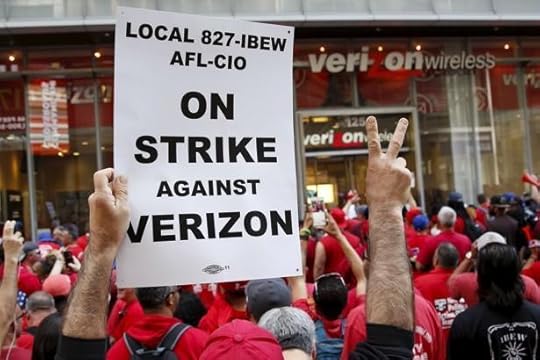
Verizon Communications reached a deal on Friday with its union workers, bringing an end to one of the largest strikes of the past decade.
The deal is an “agreement in principle,” and would mean that after it’s put in writing, Verizon and the Communications Workers of America would review the contracts. If signed, it would put more than 35,000 people back to work.
U.S. Labor Secretary Thomas Perez had helped the negotiations for the past two weeks, and in a statement he said:
Today, I am pleased to announce that the parties have reached an agreement in principle on a four-year contract, resolving the open issues in the ongoing labor dispute between Verizon’s workers, unions, and management. The parties are now working to reduce the agreement to writing, after which the proposal will be submitted to CWA and IBEW union members for ratification.
Union workers along the East Coast walked off the job on April 13 because they said Verizon wanted to cap pensions, cut benefits, and outsource some work overseas or to Mexico. Verizon said it offered to increase wages.
The strike had the potential to affect the Labor Department’s upcoming unemployment numbers.

The Atlantic’s Week in Culture

Don’t Miss
The Ethics of Hodor — Spencer Kornhaber interviews an expert about how Game of Thrones’s latest twist fits in with George R.R. Martin’s typically cliché-busting portrayal of disability
Film

20th Century Fox
X-Men: Apocalypse: A Calamitous Dud — David Sims on how the latest entry in the long-running comic-book franchise has been outstripped by its superhero-movie rivals.
I Am Your Father — Cass R. Sunstein on how Star Wars is an eternal tale of paternal love and redemption—for both George Lucas and Anakin Skywalker.
Alice Through the Looking Glass Is a $170 Million Shrug — David Sims on how the non-awaited sequel to Tim Burton’s 2010 fantasy spectacle seems almost aware of its own pointlessness.
Weiner: The Story of a Marriage — Christopher Orr on the new documentary, which explores what happens when political collapse meets personal scandal.
Thelma & Louise Holds Up Well—A Little Too Well — Megan Garber on how the film feels just as fresh today as it did in 1991.
Television

HBO
How Should Game of Thrones Kill Its Most Evil Character Ever? — Lenika Cruz on how speculation about how Ramsay Bolton might die reveals the challenges of devising a cathartic TV death—and illuminates a larger issue facing the series.
Finding My Identity Via The Fresh Prince of Bel-Air — Saidat Giwa-Osagie on how the ’90s American sitcom was crucial in helping her understand blackness as a young girl of Nigerian descent growing up in Scotland.
Where Saturday Night Live Failed This Season — David Sims on how the show had some bright spots—such as Larry David’s work as Bernie Sanders—but it largely failed to capture the zeitgeist in the year of Trump.
Game of Thrones: Sansa Stark Will Be Heard — Megan Garber on how Sansa forcing Littlefinger to hear of the violence that she endured was a moment of catharsis—not just for the character, but for the show.
Preacher: A Refreshingly Fun Comic-Book Drama — David Sims on how AMC’s new series is a ridiculous, ultra-violent thrill ride that only works because its tongue is planted firmly in cheek.
Music

Alex Kacha
Moogfest 2016: A Futurism Weighted With History and Trepidation — David Graham on the music and technology festival, where artists paid tribute to the pioneering synthesizer and its creator—sometimes more in spirit than in sound.
Finding the Magic: The Secrets of the Music Producer Daniel Lanois — David Graham talks to the Canadian musician, who has collaborated with Bob Dylan, Brian Eno, and U2.
The Noble Futility of Madonna’s Price Tribute — Spencer Kornhaber on how her patchy Billboard Awards performance is drawing the inevitable flak, but fortunately other artists will get their chances to pay homage.
Books

Barnes and Noble
Frog and Toad and the Self — Bert Clere on how Arnold Lobel’s beloved books taught children to understand and appreciate their individuality.
Games

Fabian Bimmer / Reuters
How to Play Like a Girl — Adrienne LaFrance on the line between making products children love and telling kids how they should play.
Half-Life 3: The Video Game That Never Arrived — David Sims on how a continuation of Valve’s acclaimed sci-fi series has been promised for 10 years, but seems no closer to fruition.
Fashion
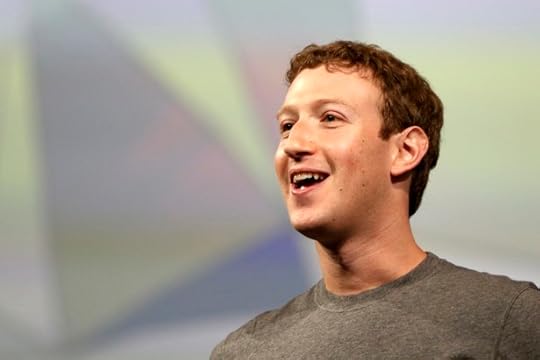
Robert Galbraith / Reuters
Casual Friday and the ‘End of the Office Dress Code’ — Megan Garber on how the day—a celebration of corporate conformity disguised as a celebration of individuality—helped to bring about the current dominance of “business casual.”

The Auction of Native American Artifacts
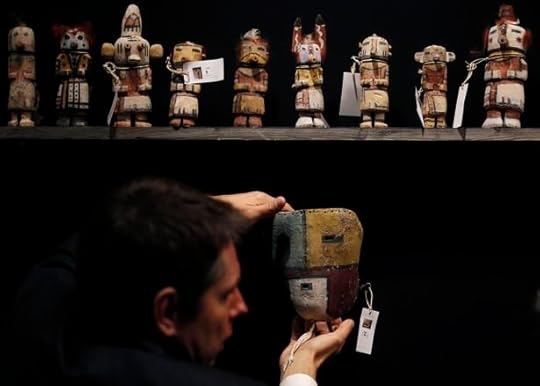
Next week an auction house in France will sell hundreds of Native American artifacts, including a Lakota Sioux warrior’s jacket made of human hair and scalps, and a Hopi ceremonial headdress from the 1880s. Native American leaders are upset about the potential sale of the artifacts they say are of cultural and religious significance.
On Tuesday, about a dozen tribal representatives gathered at the Smithsonian’s National Museum of the American Indian in Washington, D.C., for an emergency meeting to ask France to intervene.
“These objects are living beings to us,” said Bradley Marshall, of the Hoopa Valley Tribal Council in California. “These objects are part of our family; these objects are part of who we are as a people; these objects have a sacred purpose within our community.”
One of the items being sold is a battle shield from the Acoma Pueblo tribe of New Mexico that the auction house, Eve, described as “very rare” and “nineteenth century or older.”
“The Acoma shield is a sacred item that no individual can own,” Kurt Riley, the governor of the Acoma Pueblo tribe, said. “It is not made for commercial use or intended to be created as of artistic value.”
Riley became especially emotional at the meeting, and he pleaded for the auction house to return the shield to his people. After he returned to his home in New Mexico the next day, Riley told me of his frustration.
“It’s difficult,” he said, “when there’s someone else deciding what’s art and what’s cultural patrimony.”
Legally, there’s little Riley––or any Native American tribe––can do to stop the auction. In the U.S., the Native American Graves Protection and Repatriation Act gives tribes a right to claim an artifact of cultural or religious significance from museums. But internationally, the U.S. has little legal say over transactions involving Native American artifacts, as was seen the previous times French auction houses put them up for sale.
On one occasion, in 2013, Néret-Minet Tessier & Sarrou, an auction house, planned to sell 70 artifacts, most of them headdresses the Hopi regard as sacred. The Hopi live in northeastern Arizona, and their tribal council tried to stop the auction. Their chairman, LeRoy Shingoitewa, even likened it to walking into a church, yanking down the cross, then sticking it in the ground to use as a fence post. The fight over the auction gathered international attention, and when a reporter with the news site Indian Country asked the company’s auctioneer, Gilles Néret-Minet, if the negative publicity would stop the auction, Néret-Minet replied: “No—because France is a country of rights!”
The Hopi sent the auction house a copy of their constitution that outlaws selling religious items and filed several lawsuits. But the French courts sided with the sellers.
France has long been a center for the sale of tribal artifacts from much of the world, and many of these objects are prized by collectors. But for the people to whom these objects originally belonged, the items possess religious or historical value—and they want them back. That’s the root of a fear not only in France, but across other Western countries, as well. It’s a fear perhaps best articulated by Néret-Minet, when he spoke about demands to return the Hopi headdresses.
“If they can claim these objects now,” he told Indian Country in 2013, “then African art is over, and the Cluny museum [of medieval objects, in Paris] would give back all of its pieces to the churches. If we are questioning the principle of ‘religious art,’ we should question the entire notion of art.”
The auction went forward in April 2013, making $1.2 million. One of the winners was Monroe Warshaw, an American art collector and exhibitor who bought two of the “Katsina” ceremonial headdresses, some of the most sacred objects of the Hopi people. Warshaw had little idea of the items’ history, or of the controversy around them. Of his impulsive buy, he simply thought they were gorgeous, he told me. “I had never seen such things.”
Warshaw saw beauty, history, and inspiration in the headdress. They were the qualities a collectors wants in art. But the Hopi saw more—as did the Acoma Pueblo tribe in a battle shield that is up for sale next week in Paris. The Acoma have lived on their land, about an hour from Albuquerque, New Mexico, for more than 800 years. When Riley, the Acoma governor, learned the shield was being auctioned, he consulted the tribe’s religious leaders who asked their office of historic preservation to investigate.
It’s not clear when the Acoma lost the shield, but one possibility is in the 1920s, when Protestant missionaries proselytized to the Acoma to give up their old religions. The investigative team found the shield had, in fact, belonged to an Acoma family, Riley said. It was a special find, because in a small community as old as the Acoma, culture, religion, family history, are all imbued inside some artifacts. And though those items may have been looked after by a single family, they are seen as belonging to the entire community if they are of religious importance.
“The shield is one of those items,” Riley said.
Through the tribe’s lawyers, Riley said he asked the auction house to return to shield. They said he could bid on it. Now he fears it will be lost, unless someone can help.
In the past, when tribes can’t buy back their own artifacts, other have done it for them. That was the case in 2015 when the Eve auction house––the same one auctioning the shield next week––sold off 27 Katsina headdress, the ones the Hopi people believe hold spirits. The Hopi hired a lawyer and asked the U.S. government to intervene, but were unsuccessful. From their homes in Arizona, some Hopi watched online as one bidder bought nearly every headdress. The anonymous bidder, later revealed to be the Annenberg Foundation, paid $530,695 and bought all but three of the sacred Hopi objects. The foundation eventually returned them to the Hopi. Although he didn’t know it yet, Warshaw, the American collector who bought the headdresses at the Néret-Minet Tessier & Sarrou auction in 2013, would end up doing the same thing.
Just after the auction in 2013, Warshaw told a reporter he didn’t believe the tribe should get them back, because the Hopi only wanted the headdresses now that they “have a value.” Warshaw, who collects and sells drawings by renowned masters, didn’t know what he’d do with the two Hopi pieces for which he’d paid $40,000, but he figured he’d donate them to a museum.
Warshaw had traveled to Paris in the midst of a nine-month road trip around the U.S. with his golden retriever, Pastrami. In June 2013, two months after the auction, Warshaw thought he’d drive up to see the Hopi people for himself. By the end of that month, he and Pastrami were high in the plateaued deserts, seated in an old village, watching Hopi ceremonial dancers who all wore the same sacred headdresses he’d bought in Paris.
“I realized,” he told me, “these objects, these headdresses, still lived with them.”
And so he gave them back.

Is North Korea Behind Bank Heists?

Security investigators linked thefts from banks in Asia, including the $81 million stolen from the central bank of Bangladesh in February, to a hacking group in North Korea.
The research firm Symantec has been looking into the Bangladesh bank heist, and on Thursday it posted on its blog that a similar code used to steal Bangladesh’s millions was also used to hack a bank in the Philippines, as well as a failed attempt on a bank in Vietnam last year. The code, Symantec said, has also been linked to the 2014 hack of Sony Pictures’s emails.
Investigators say the malware the thieves used shared similarities to the code used by a hacking group known as Lazarus. The FBI has linked this group to the Sony hacks, and those hacks to North Korea. That group has also been tied to attacks as far back as 2009, which mainly focused on the U.S. and South Korea, but it is also believed to be responsible for hacks on countries all over the world, such as the $12 million stolen from an Ecuadoran bank last year.
The way hackers broke into the banks was by infiltrating the industry’s global messaging system, SWIFT. The system is run by the world’s largest banks, is based in Brussels, and prides itself on security.
The New York Times adds:
North Korea’s economy has been ravaged by sanctions, food shortages and other deprivations. Pyongyang does not publish economic data, but estimates have put North Korea’s gross domestic product between $12 billion and $40 billion, tiny when compared with South Korea’s economic output of more than $1.4 trillion.
An expert quoted by the Times said: “If you presume it’s North Korea, $1 billion is almost 10 percent of their G.D.P. This is not small change for them.”
Since investigators learned how hackers stole Bangladesh’s money, banks that had kept similar heists quiet have come forward: Just last week, it was revealed in a lawsuit that the Banco del Austro in Ecuador was targeted, as well.

Atlantic Monthly Contributors's Blog
- Atlantic Monthly Contributors's profile
- 1 follower



